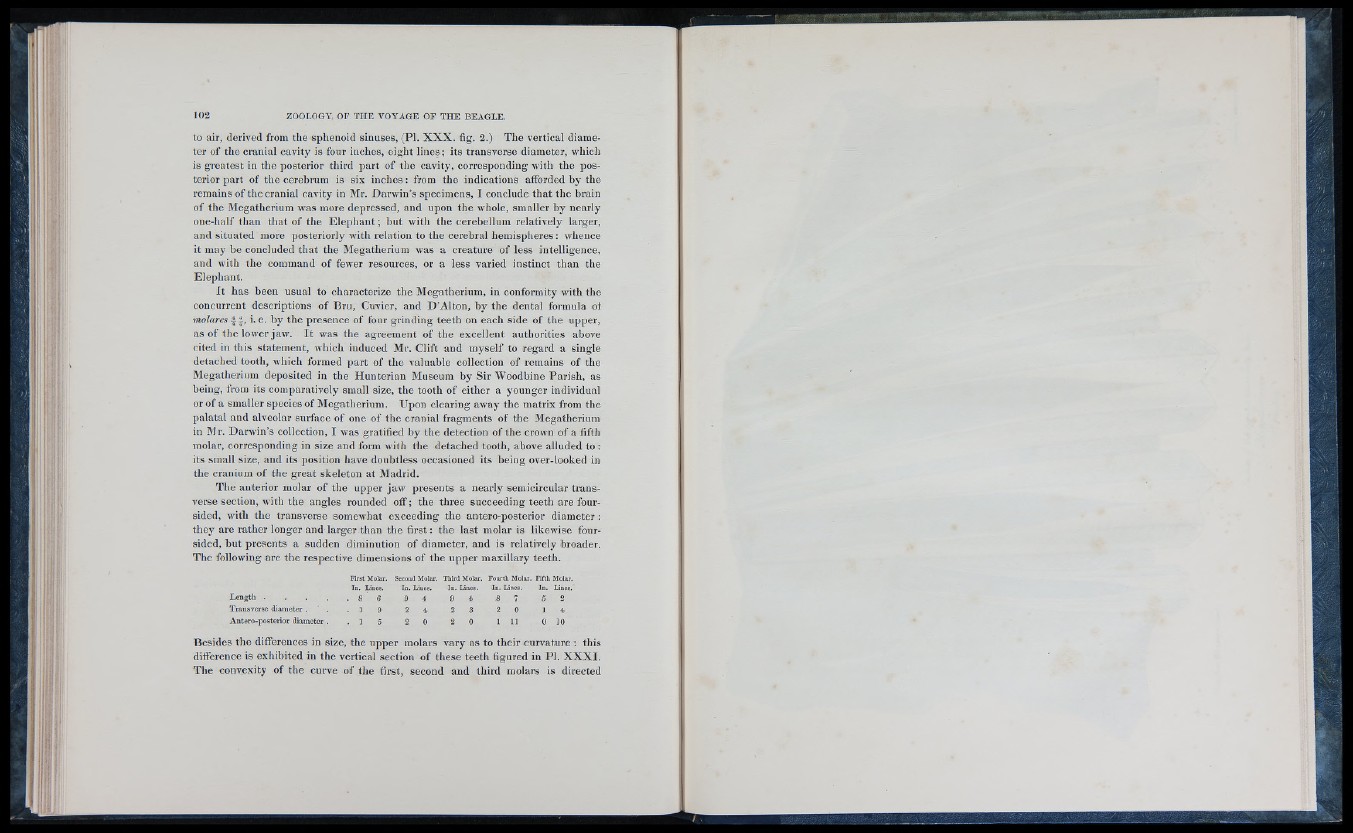
to air, derived from the sphenoid sinuses, (PL X X X . fig. 2 .) The vertical diameter
o f the cranial cavity is four inches, eight line s; its transverse diameter, which
is greatest in the posterior third part o f the cavity, corresponding with the posterior
part o f the cerebrum is six in c lie s : from the indications afforded by the
remains o f the cranial cavity in Mr. Darwin’s specimens, I conclude that the brain
o f the Megatherium was more depressed, and upon the whole, smaller by nearly
one-half than that o f the Eleph an t; but with the cerebellum relatively larger,
and situated more posteriorly with relation to the cerebral hem isphe res: whence
it may be concluded that the Megatherium was a creature o f le ss intelligence,
and with the command o f fewer resources, or a le ss varied instinct than the
Elephant.
It has been usual to characterize the Megatherium, in conformity with the
concurrent descriptions o f Bru, Cuvier, and D ’Alton, b y the dental formula of
molares i. e. by the presence o f four grinding teeth on each side o f the upper,
as o f the lower jaw. It was the agreement o f the ex c e llent authorities above
cited in this statement, which induced Mr. Clift and m y se lf to regard a single
detached tooth, which formed part of the valuable collection o f remains of the
Megatherium deposited in the Hunterian Museum by Sir Woodbine Parish, as
being, from its comparatively small size, the tooth of either a younger individual
or o f a smaller spe cie s o f Megatherium. Upon clearing away the matrix from the
palatal and alveolar surface o f one o f the cranial fragments o f the Megatherium
in Mr. Darwin’s collection, I was gratified by the detection o f the crown o f a fifth
molar, corresponding in size and form with the detached tooth, above alluded t o :
its small size, and its position have doubtless occasioned its being over-looked in
the cranium o f the great skeleton at Madrid.
The anterior molar o f the u p p e r jaw presents a nearly semicircular transverse
section, with the angles rounded off; the three suc ceeding teeth are four-
sided, with the transverse somewhat exc eeding the antero-posterior diameter :
they are rather longer and larger than the fir st: the la st molar is likewise foursided,
but presents a sudden diminution o f diameter, and is relatively broader.
The following are the respective dimensions o f the upper maxillary teeth.
Length . . . .
Transverse diameter . ' .
Antero-posterior diameter .
Second Molar. Third Molar, Fourth Molar. Fifth Molar.
In . Liues. In . Lines. In . Lincs. In . Lines.
0 4 9 4 8 7 5 2
2 4 2 8 2 0 1 4
2 0 2 0 1 11 0 10
B e sid e s the differences in size, the upper molars vary as to their curvature : this
difference is exliibited in the vertical section o f these teeth figured in PL X X X I .
The convexity o f the curve o f the first, second and third molars is directed
m m Ê Ê È à
m